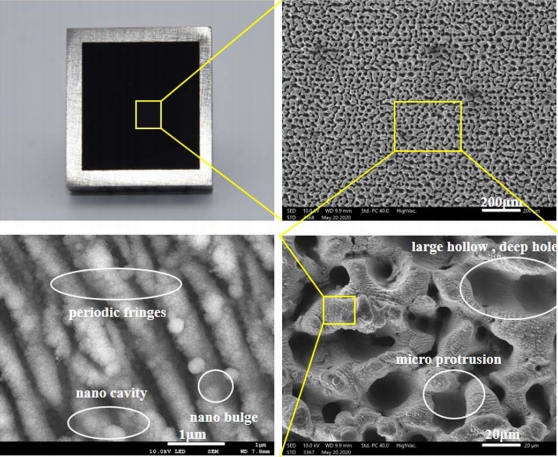To fabricate micro/nano structures on metal surfaces, various technologies have been proposed, including chemical etching, mechanical grooving, reactive ion etching, and long-pulse laser processing.
Ultrafast laser manufacturing technology is one of the relatively ideal technologies for fabricating light-trapping structure surfaces. However, to simply and effectively achieve broadband effectiveness and ultralow average reflectivity performance on metal surfaces still remains challenging.
A research team led by Prof. LIU Hongjun from Xi'an Institute of Optics and Precision Mechanics (XIOPM) of the Chinese Academy of Sciences (CAS) proposed an effective and simple method for fabricating the micro/nano hybrid structures on metal surfaces by adjusting femtosecond laser fluence, scanning interval, and polarization.
The results were published in CHINESE OPTICS LETTERS.

The researchers used a TC7 titanium alloy sample with a size of 25 mm × 25 mm × 10 mm. They cleaned the mechanically polished surface of the sample in an ultrasonic cleaner with anhydrous ethanol and deionized water before laser treatment. An industrial fs laser with a high repetition rate (1 MHz) and the highest power (20 W) was employed for metal surface modification.
"We find that the morphology of the samples fabricated by the fs laser changed greatly under different laser processing parameters," said Dr. LIU. Moreover, an ultralow average reflectivity of 2% in the 250-2300 nm spectral band and minimum 1.5% reflectivity in UV band could be achieved.
According to the absorption principle of periodic nanostructures, the smaller the fringe period, the better the resonance absorption of the short wave. Since the hybrid nanostructure induced by circularly polarized light has a smaller fringe period, it shows an excellent absorption of the short wave.
By employing the proposed method, large areas of the micro/nano hybrid structures with high consistency could be achieved for practical applications.






